headrest NISSAN QASHQAI 2023 Owners Manual
[x] Cancel search | Manufacturer: NISSAN, Model Year: 2023, Model line: QASHQAI, Model: NISSAN QASHQAI 2023Pages: 508, PDF Size: 2.47 MB
Page 19 of 508
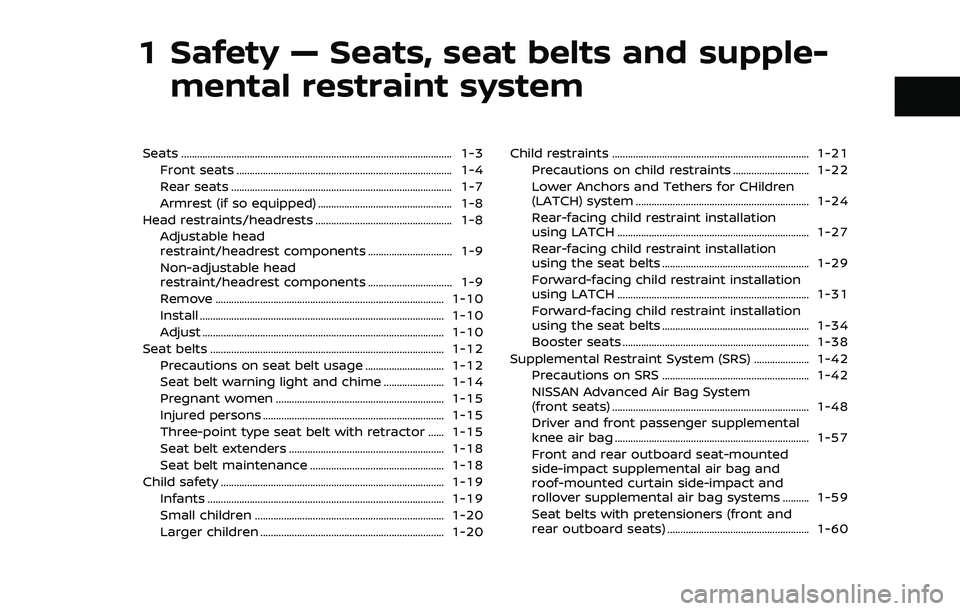
1 Safety — Seats, seat belts and supple-mental restraint system
Seats ........................................................................\
............................... 1-3
Front seats ........................................................................\
.......... 1-4
Rear seats ........................................................................\
............ 1-7
Armrest (if so equipped) ................................................... 1-8
Head restraints/headrests .................................................... 1-8 Adjustable head
restraint/headrest components ................................ 1-9
Non-adjustable head
restraint/headrest components ................................ 1-9
Remove ........................................................................\
............... 1-10
Install ........................................................................\
..................... 1-10
Adjust ........................................................................\
.................... 1-10
Seat belts ........................................................................\
................. 1-12
Precautions on seat belt usage .............................. 1-12
Seat belt warning light and chime ....................... 1-14
Pregnant women ................................................................ 1-15
Injured persons ..................................................................... 1-15
Three-point type seat belt with retractor ...... 1-15
Seat belt extenders ........................................................... 1-18
Seat belt maintenance ................................................... 1-18
Child safety ........................................................................\
............. 1-19 Infants ........................................................................\
.................. 1-19
Small children ........................................................................\
1-20
Larger children ...................................................................... 1-20 Child restraints ........................................................................\
... 1-21
Precautions on child restraints ............................. 1-22
Lower Anchors and Tethers for CHildren
(LATCH) system .................................................................. 1-24
Rear-facing child restraint installation
using LATCH ........................................................................\
. 1-27
Rear-facing child restraint installation
using the seat belts ........................................................ 1-29
Forward-facing child restraint installation
using LATCH ........................................................................\
. 1-31
Forward-facing child restraint installation
using the seat belts ........................................................ 1-34
Booster seats ....................................................................... 1-38
Supplemental Restraint System (SRS) ..................... 1-42 Precautions on SRS ........................................................ 1-42
NISSAN Advanced Air Bag System
(front seats) ........................................................................\
... 1-48
Driver and front passenger supplemental
knee air bag ........................................................................\
.. 1-57
Front and rear outboard seat-mounted
side-impact supplemental air bag and
roof-mounted curtain side-impact and
rollover supplemental air bag systems .......... 1-59
Seat belts with pretensioners (front and
rear outboard seats) ...................................................... 1-60
Page 26 of 508
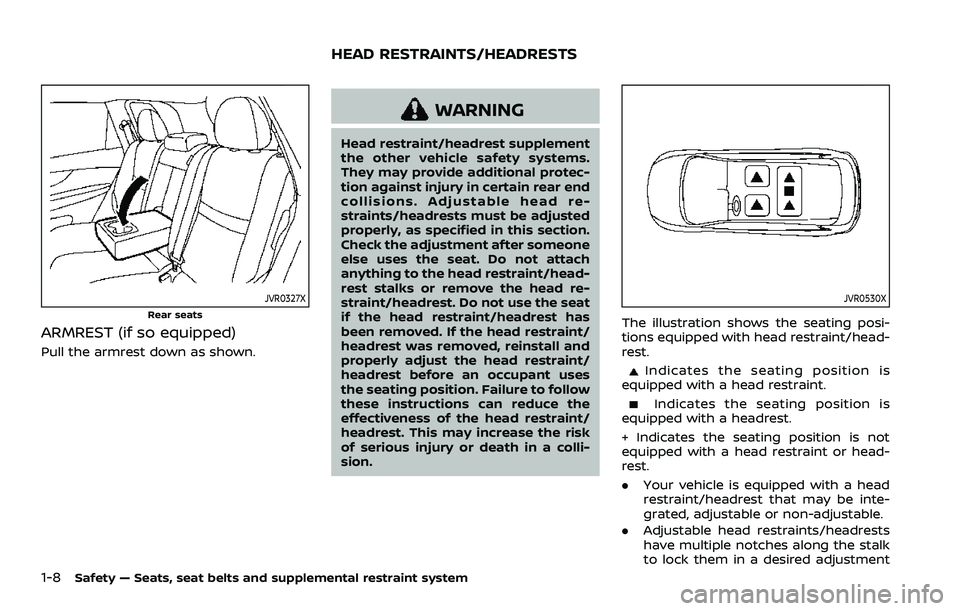
1-8Safety — Seats, seat belts and supplemental restraint system
JVR0327X
Rear seats
ARMREST (if so equipped)
Pull the armrest down as shown.
WARNING
Head restraint/headrest supplement
the other vehicle safety systems.
They may provide additional protec-
tion against injury in certain rear end
collisions. Adjustable head re-
straints/headrests must be adjusted
properly, as specified in this section.
Check the adjustment after someone
else uses the seat. Do not attach
anything to the head restraint/head-
rest stalks or remove the head re-
straint/headrest. Do not use the seat
if the head restraint/headrest has
been removed. If the head restraint/
headrest was removed, reinstall and
properly adjust the head restraint/
headrest before an occupant uses
the seating position. Failure to follow
these instructions can reduce the
effectiveness of the head restraint/
headrest. This may increase the risk
of serious injury or death in a colli-
sion.
JVR0530X
The illustration shows the seating posi-
tions equipped with head restraint/head-
rest.
Indicates the seating position is
equipped with a head restraint.
Indicates the seating position is
equipped with a headrest.
+ Indicates the seating position is not
equipped with a head restraint or head-
rest.
. Your vehicle is equipped with a head
restraint/headrest that may be inte-
grated, adjustable or non-adjustable.
. Adjustable head restraints/headrests
have multiple notches along the stalk
to lock them in a desired adjustment
HEAD RESTRAINTS/HEADRESTS
Page 27 of 508
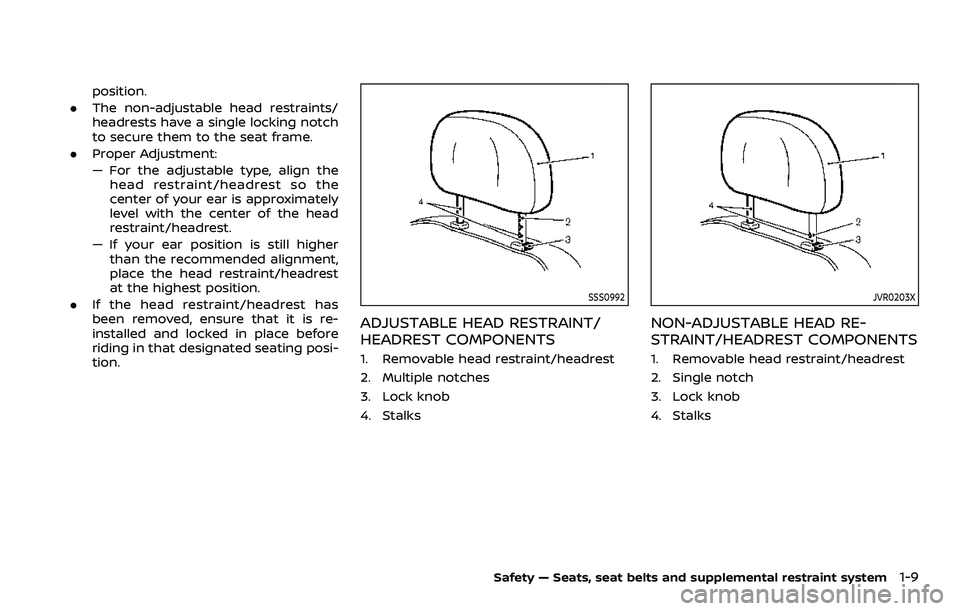
position.
. The non-adjustable head restraints/
headrests have a single locking notch
to secure them to the seat frame.
. Proper Adjustment:
— For the adjustable type, align the
head restraint/headrest so the
center of your ear is approximately
level with the center of the head
restraint/headrest.
— If your ear position is still higher than the recommended alignment,
place the head restraint/headrest
at the highest position.
. If the head restraint/headrest has
been removed, ensure that it is re-
installed and locked in place before
riding in that designated seating posi-
tion.
SSS0992
ADJUSTABLE HEAD RESTRAINT/
HEADREST COMPONENTS
1. Removable head restraint/headrest
2. Multiple notches
3. Lock knob
4. Stalks
JVR0203X
NON-ADJUSTABLE HEAD RE-
STRAINT/HEADREST COMPONENTS
1. Removable head restraint/headrest
2. Single notch
3. Lock knob
4. Stalks
Safety — Seats, seat belts and supplemental restraint system1-9
Page 28 of 508
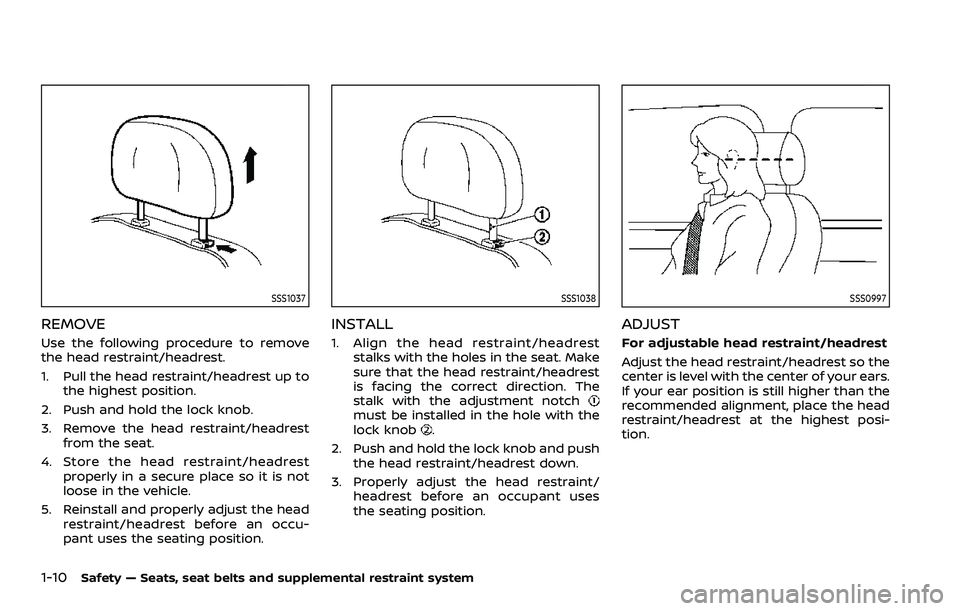
1-10Safety — Seats, seat belts and supplemental restraint system
SSS1037
REMOVE
Use the following procedure to remove
the head restraint/headrest.
1. Pull the head restraint/headrest up tothe highest position.
2. Push and hold the lock knob.
3. Remove the head restraint/headrest from the seat.
4. Store the head restraint/headrest properly in a secure place so it is not
loose in the vehicle.
5. Reinstall and properly adjust the head restraint/headrest before an occu-
pant uses the seating position.
SSS1038
INSTALL
1. Align the head restraint/headreststalks with the holes in the seat. Make
sure that the head restraint/headrest
is facing the correct direction. The
stalk with the adjustment notch
must be installed in the hole with the
lock knob.
2. Push and hold the lock knob and push the head restraint/headrest down.
3. Properly adjust the head restraint/ headrest before an occupant uses
the seating position.
SSS0997
ADJUST
For adjustable head restraint/headrest
Adjust the head restraint/headrest so the
center is level with the center of your ears.
If your ear position is still higher than the
recommended alignment, place the head
restraint/headrest at the highest posi-
tion.
Page 29 of 508
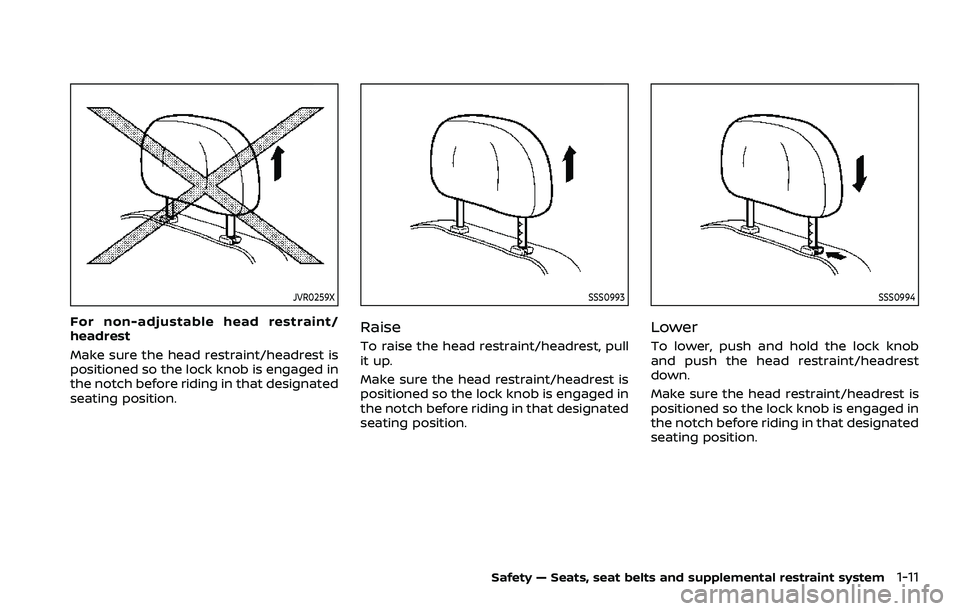
JVR0259X
For non-adjustable head restraint/
headrest
Make sure the head restraint/headrest is
positioned so the lock knob is engaged in
the notch before riding in that designated
seating position.
SSS0993
Raise
To raise the head restraint/headrest, pull
it up.
Make sure the head restraint/headrest is
positioned so the lock knob is engaged in
the notch before riding in that designated
seating position.
SSS0994
Lower
To lower, push and hold the lock knob
and push the head restraint/headrest
down.
Make sure the head restraint/headrest is
positioned so the lock knob is engaged in
the notch before riding in that designated
seating position.
Safety — Seats, seat belts and supplemental restraint system1-11
Page 38 of 508
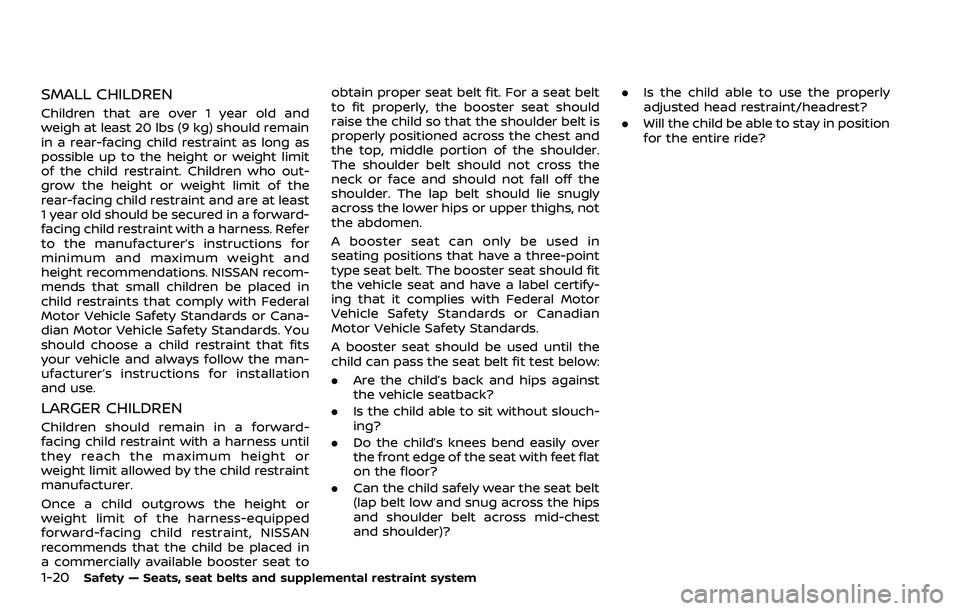
1-20Safety — Seats, seat belts and supplemental restraint system
SMALL CHILDREN
Children that are over 1 year old and
weigh at least 20 lbs (9 kg) should remain
in a rear-facing child restraint as long as
possible up to the height or weight limit
of the child restraint. Children who out-
grow the height or weight limit of the
rear-facing child restraint and are at least
1 year old should be secured in a forward-
facing child restraint with a harness. Refer
to the manufacturer’s instructions for
minimum and maximum weight and
height recommendations. NISSAN recom-
mends that small children be placed in
child restraints that comply with Federal
Motor Vehicle Safety Standards or Cana-
dian Motor Vehicle Safety Standards. You
should choose a child restraint that fits
your vehicle and always follow the man-
ufacturer’s instructions for installation
and use.
LARGER CHILDREN
Children should remain in a forward-
facing child restraint with a harness until
they reach the maximum height or
weight limit allowed by the child restraint
manufacturer.
Once a child outgrows the height or
weight limit of the harness-equipped
forward-facing child restraint, NISSAN
recommends that the child be placed in
a commercially available booster seat toobtain proper seat belt fit. For a seat belt
to fit properly, the booster seat should
raise the child so that the shoulder belt is
properly positioned across the chest and
the top, middle portion of the shoulder.
The shoulder belt should not cross the
neck or face and should not fall off the
shoulder. The lap belt should lie snugly
across the lower hips or upper thighs, not
the abdomen.
A booster seat can only be used in
seating positions that have a three-point
type seat belt. The booster seat should fit
the vehicle seat and have a label certify-
ing that it complies with Federal Motor
Vehicle Safety Standards or Canadian
Motor Vehicle Safety Standards.
A booster seat should be used until the
child can pass the seat belt fit test below:
.
Are the child’s back and hips against
the vehicle seatback?
. Is the child able to sit without slouch-
ing?
. Do the child’s knees bend easily over
the front edge of the seat with feet flat
on the floor?
. Can the child safely wear the seat belt
(lap belt low and snug across the hips
and shoulder belt across mid-chest
and shoulder)? .
Is the child able to use the properly
adjusted head restraint/headrest?
. Will the child be able to stay in position
for the entire ride?
Page 52 of 508
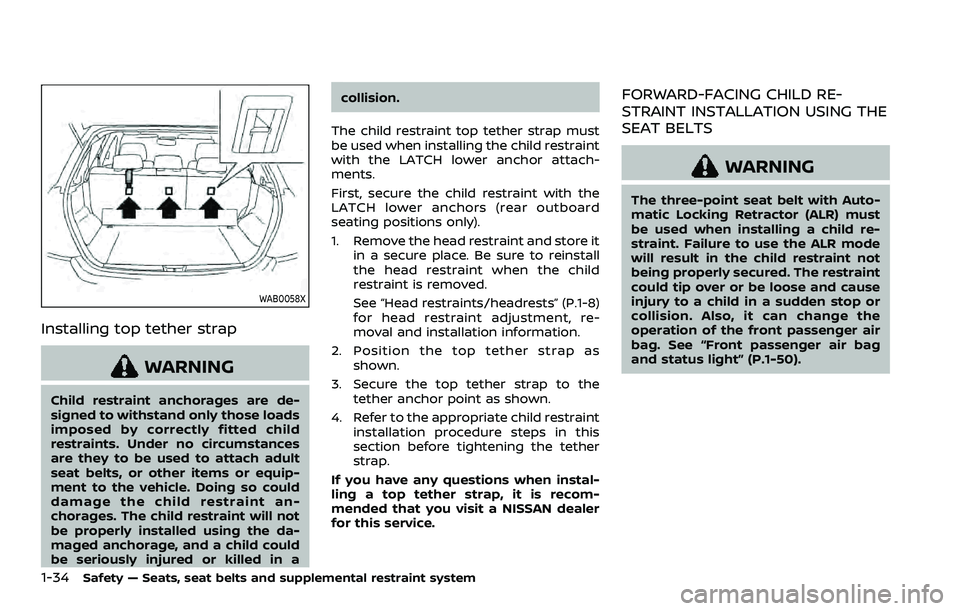
1-34Safety — Seats, seat belts and supplemental restraint system
WAB0058X
Installing top tether strap
WARNING
Child restraint anchorages are de-
signed to withstand only those loads
imposed by correctly fitted child
restraints. Under no circumstances
are they to be used to attach adult
seat belts, or other items or equip-
ment to the vehicle. Doing so could
damage the child restraint an-
chorages. The child restraint will not
be properly installed using the da-
maged anchorage, and a child could
be seriously injured or killed in acollision.
The child restraint top tether strap must
be used when installing the child restraint
with the LATCH lower anchor attach-
ments.
First, secure the child restraint with the
LATCH lower anchors (rear outboard
seating positions only).
1. Remove the head restraint and store it in a secure place. Be sure to reinstall
the head restraint when the child
restraint is removed.
See “Head restraints/headrests” (P.1-8)
for head restraint adjustment, re-
moval and installation information.
2. Position the top tether strap as shown.
3. Secure the top tether strap to the tether anchor point as shown.
4. Refer to the appropriate child restraint installation procedure steps in this
section before tightening the tether
strap.
If you have any questions when instal-
ling a top tether strap, it is recom-
mended that you visit a NISSAN dealer
for this service.
FORWARD-FACING CHILD RE-
STRAINT INSTALLATION USING THE
SEAT BELTS
WARNING
The three-point seat belt with Auto-
matic Locking Retractor (ALR) must
be used when installing a child re-
straint. Failure to use the ALR mode
will result in the child restraint not
being properly secured. The restraint
could tip over or be loose and cause
injury to a child in a sudden stop or
collision. Also, it can change the
operation of the front passenger air
bag. See “Front passenger air bag
and status light” (P.1-50).
Page 56 of 508
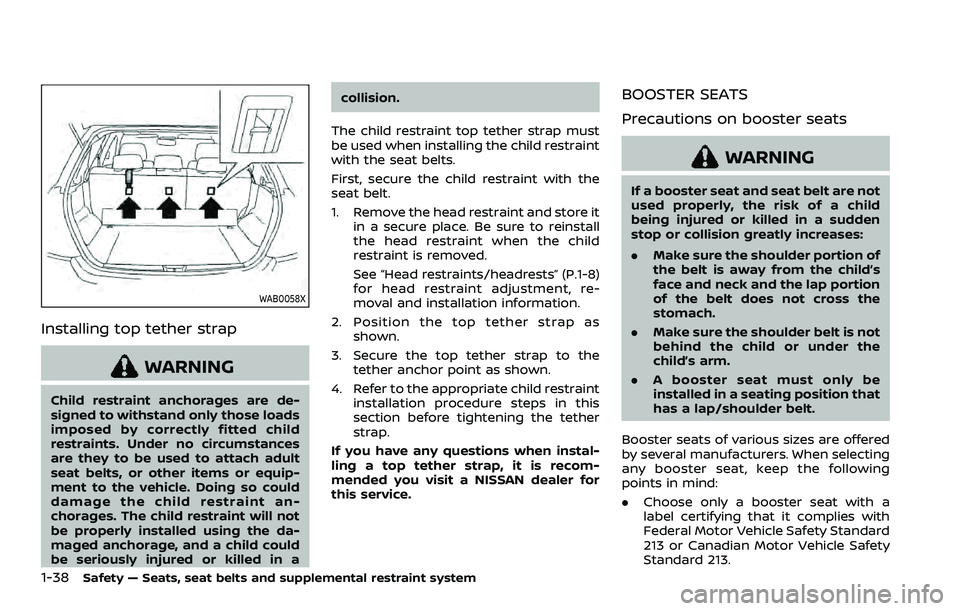
1-38Safety — Seats, seat belts and supplemental restraint system
WAB0058X
Installing top tether strap
WARNING
Child restraint anchorages are de-
signed to withstand only those loads
imposed by correctly fitted child
restraints. Under no circumstances
are they to be used to attach adult
seat belts, or other items or equip-
ment to the vehicle. Doing so could
damage the child restraint an-
chorages. The child restraint will not
be properly installed using the da-
maged anchorage, and a child could
be seriously injured or killed in acollision.
The child restraint top tether strap must
be used when installing the child restraint
with the seat belts.
First, secure the child restraint with the
seat belt.
1. Remove the head restraint and store it in a secure place. Be sure to reinstall
the head restraint when the child
restraint is removed.
See “Head restraints/headrests” (P.1-8)
for head restraint adjustment, re-
moval and installation information.
2. Position the top tether strap as shown.
3. Secure the top tether strap to the tether anchor point as shown.
4. Refer to the appropriate child restraint installation procedure steps in this
section before tightening the tether
strap.
If you have any questions when instal-
ling a top tether strap, it is recom-
mended you visit a NISSAN dealer for
this service.
BOOSTER SEATS
Precautions on booster seats
WARNING
If a booster seat and seat belt are not
used properly, the risk of a child
being injured or killed in a sudden
stop or collision greatly increases:
. Make sure the shoulder portion of
the belt is away from the child’s
face and neck and the lap portion
of the belt does not cross the
stomach.
. Make sure the shoulder belt is not
behind the child or under the
child’s arm.
. A booster seat must only be
installed in a seating position that
has a lap/shoulder belt.
Booster seats of various sizes are offered
by several manufacturers. When selecting
any booster seat, keep the following
points in mind:
. Choose only a booster seat with a
label certifying that it complies with
Federal Motor Vehicle Safety Standard
213 or Canadian Motor Vehicle Safety
Standard 213.
Page 59 of 508
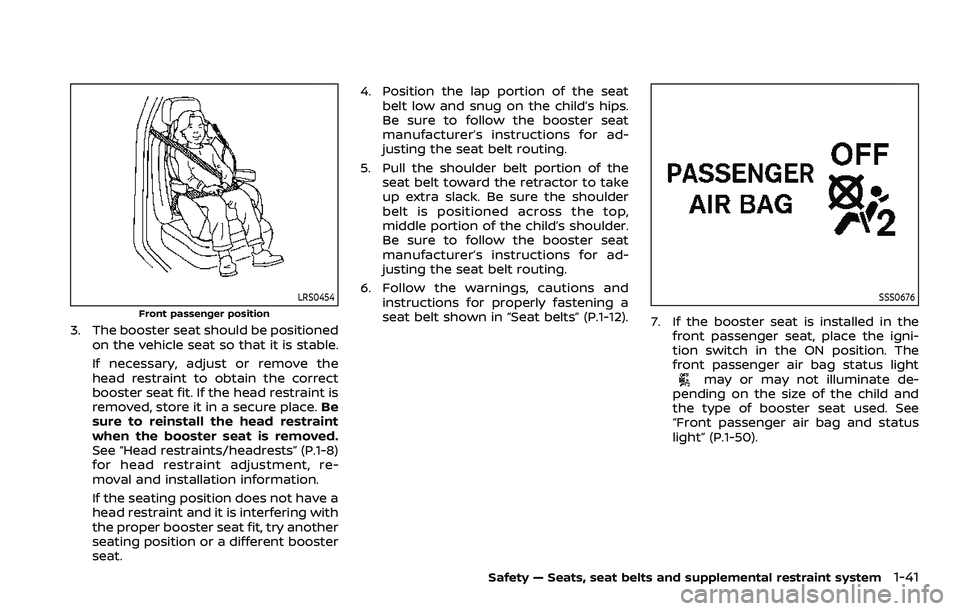
LRS0454
Front passenger position
3. The booster seat should be positionedon the vehicle seat so that it is stable.
If necessary, adjust or remove the
head restraint to obtain the correct
booster seat fit. If the head restraint is
removed, store it in a secure place. Be
sure to reinstall the head restraint
when the booster seat is removed.
See “Head restraints/headrests” (P.1-8)
for head restraint adjustment, re-
moval and installation information.
If the seating position does not have a
head restraint and it is interfering with
the proper booster seat fit, try another
seating position or a different booster
seat. 4. Position the lap portion of the seat
belt low and snug on the child’s hips.
Be sure to follow the booster seat
manufacturer’s instructions for ad-
justing the seat belt routing.
5. Pull the shoulder belt portion of the seat belt toward the retractor to take
up extra slack. Be sure the shoulder
belt is positioned across the top,
middle portion of the child’s shoulder.
Be sure to follow the booster seat
manufacturer’s instructions for ad-
justing the seat belt routing.
6. Follow the warnings, cautions and instructions for properly fastening a
seat belt shown in “Seat belts” (P.1-12).
SSS0676
7. If the booster seat is installed in thefront passenger seat, place the igni-
tion switch in the ON position. The
front passenger air bag status light
may or may not illuminate de-
pending on the size of the child and
the type of booster seat used. See
“Front passenger air bag and status
light” (P.1-50).
Safety — Seats, seat belts and supplemental restraint system1-41
Page 501 of 508
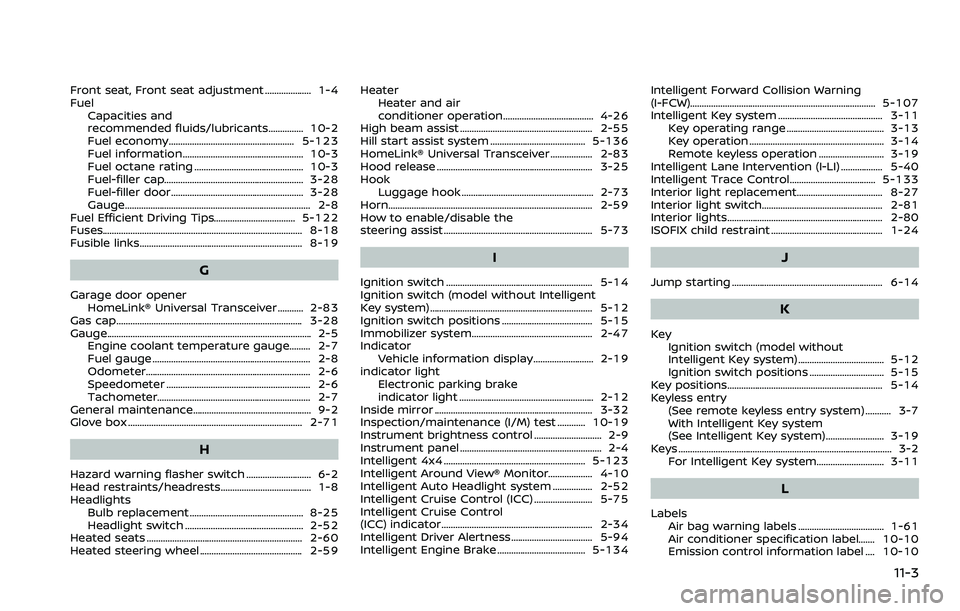
Front seat, Front seat adjustment .................... 1-4
FuelCapacities and
recommended fluids/lubricants............... 10-2
Fuel economy...................................................... 5-123
Fuel information.................................................... 10-3
Fuel octane rating ............................................... 10-3
Fuel-filler cap............................................................ 3-28
Fuel-filler door......................................................... 3-28
Gauge........................................................................\
........ 2-8
Fuel Efficient Driving Tips................................... 5-122
Fuses........................................................................\
.............. 8-18
Fusible links...................................................................... 8-19
G
Garage door opener HomeLink® Universal Transceiver ........... 2-83
Gas cap........................................................................\
........ 3-28
Gauge........................................................................\
................ 2-5 Engine coolant temperature gauge......... 2-7
Fuel gauge .................................................................... 2-8
Odometer....................................................................... 2-6
Speedometer .............................................................. 2-6
Tachometer.................................................................. 2-7
General maintenance................................................... 9-2
Glove box ........................................................................\
... 2-71
H
Hazard warning flasher switch ............................ 6-2
Head restraints/headrests....................................... 1-8
Headlights Bulb replacement ................................................. 8-25
Headlight switch ................................................... 2-52
Heated seats ................................................................... 2-60
Heated steering wheel ............................................ 2-59 Heater
Heater and air
conditioner operation....................................... 4-26
High beam assist ......................................................... 2-55
Hill start assist system ......................................... 5-136
HomeLink® Universal Transceiver .................. 2-83
Hood release ................................................................... 3-25
Hook Luggage hook ......................................................... 2-73
Horn........................................................................\
................ 2-59
How to enable/disable the
steering assist ................................................................ 5-73
I
Ignition switch ............................................................... 5-14
Ignition switch (model without Intelligent
Key system) ...................................................................... 5-12
Ignition switch positions ....................................... 5-15
Immobilizer system.................................................... 2-47
Indicator Vehicle information display.......................... 2-19
indicator light Electronic parking brake
indicator light .......................................................... 2-12
Inside mirror .................................................................... 3-32
Inspection/maintenance (I/M) test ............ 10-19
Instrument brightness control ............................. 2-9
Instrument panel ............................................................. 2-4
Intelligent 4x4 ............................................................. 5-123
Intelligent Around View® Monitor................... 4-10
Intelligent Auto Headlight system ................. 2-52
Intelligent Cruise Control (ICC) ......................... 5-75
Intelligent Cruise Control
(ICC) indicator ................................................................. 2-34
Intelligent Driver Alertness................................... 5-94
Intelligent Engine Brake ...................................... 5-134 Intelligent Forward Collision Warning
(I-FCW)........................................................................\
........ 5-107
Intelligent Key system ............................................. 3-11
Key operating range .......................................... 3-13
Key operation .......................................................... 3-14
Remote keyless operation ............................ 3-19
Intelligent Lane Intervention (I-LI) .................. 5-40
Intelligent Trace Control..................................... 5-133
Interior light replacement..................................... 8-27
Interior light switch.................................................... 2-81
Interior lights................................................................... 2-80
ISOFIX child restraint ................................................ 1-24
J
Jump starting ................................................................. 6-14
K
Key Ignition switch (model without
Intelligent Key system) ..................................... 5-12
Ignition switch positions ................................ 5-15
Key positions................................................................... 5-14
Keyless entry (See remote keyless entry system) ........... 3-7
With Intelligent Key system
(See Intelligent Key system) ......................... 3-19
Keys ........................................................................\
.................... 3-2 For Intelligent Key system............................. 3-11
L
LabelsAir bag warning labels ..................................... 1-61
Air conditioner specification label....... 10-10
Emission control information label .... 10-10
11-3